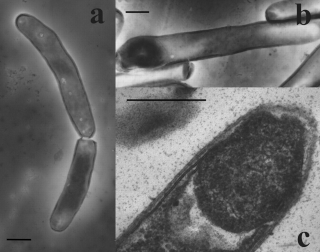Sulfur-reducing bacteria are microorganisms able to reduce elemental sulfur (S0) to hydrogen sulfide (H2S). These microbes use inorganic sulfur compounds as electron acceptors to sustain several activities such as respiration, conserving energy and growth, in absence of oxygen. The final product of these processes, sulfide, has a considerable influence on the chemistry of the environment and, in addition, is used as electron donor for a large variety of microbial metabolisms. Several types of bacteria and many non-methanogenic archaea can reduce sulfur. Microbial sulfur reduction was already shown in early studies, which highlighted the first proof of S0 reduction in a vibrioid bacterium from mud, with sulfur as electron acceptor and H
2 as electron donor. The first pure cultured species of sulfur-reducing bacteria, Desulfuromonas acetoxidans, was discovered in 1976 and described by Pfennig Norbert and Biebel Hanno as an anaerobic sulfur-reducing and acetate-oxidizing bacterium, not able to reduce sulfate. Only few taxa are true sulfur-reducing bacteria, using sulfur reduction as the only or main catabolic reaction. Normally, they couple this reaction with the oxidation of acetate, succinate or other organic compounds. In general, sulfate-reducing bacteria are able to use both sulfate and elemental sulfur as electron acceptors. Thanks to its abundancy and thermodynamic stability, sulfate is the most studied electron acceptor for anaerobic respiration that involves sulfur compounds. Elemental sulfur, however, is very abundant and important, especially in deep-sea hydrothermal vents, hot springs and other extreme environments, making its isolation more difficult. Some bacteria – such as Proteus, Campylobacter, Pseudomonas and Salmonella – have the ability to reduce sulfur, but can also use oxygen and other terminal electron acceptors.

Acidilobales are an order of archaea in the class Thermoprotei.
Pyrobaculum is a genus of the Thermoproteaceae.

Acidilobus is a genus of archaea in the family Acidilobaceae.
Thermococcus litoralis is a species of Archaea that is found around deep-sea hydrothermal vents as well as shallow submarine thermal springs and oil wells. It is an anaerobic organotroph hyperthermophile that is between 0.5–3.0 μm (20–118 μin) in diameter. Like the other species in the order thermococcales, T. litoralis is an irregular hyperthermophile coccus that grows between 55–100 °C (131–212 °F). Unlike many other thermococci, T. litoralis is non-motile. Its cell wall consists only of a single S-layer that does not form hexagonal lattices. Additionally, while many thermococcales obligately use sulfur as an electron acceptor in metabolism, T. litoralis only needs sulfur to help stimulate growth, and can live without it. T. litoralis has recently been popularized by the scientific community for its ability to produce an alternative DNA polymerase to the commonly used Taq polymerase. The T. litoralis polymerase, dubbed the vent polymerase, has been shown to have a lower error rate than Taq but due to its proofreading 3’–5’ exonuclease abilities.
Thermoanaerobacter is a genus in the phylum Bacillota (Bacteria). Members of this genus are thermophilic and anaerobic, several of them were previously described as Clostridium species and members of the now obsolete genera Acetogenium and Thermobacteroides
Thermoplasma volcanium is a moderate thermoacidophilic archaea isolated from acidic hydrothermal vents and solfatara fields. It contains no cell wall and is motile. It is a facultative anaerobic chemoorganoheterotroph. No previous phylogenetic classifications have been made for this organism. Thermoplasma volcanium reproduces asexually via binary fission and is nonpathogenic.
Thermococcus stetteri is an extremely thermophilic, marine, sulfur-metabolizing archaebacterium. It is anaerobic, its cells being irregular cocci 1 to 2 μm in diameter. Of the strains first isolated, two were motile due to a tuft of flagella, while the other two strains were nonmotile. Its type strain is K-3. It can grow on starch, pectin, and peptides, but not amino acids.
Desulfurella kamchatkensis is a thermophilic sulfur-reducing eubacterium. It is Gram-negative, rod-shaped, motile, with a single polar flagellum and type strain K-119T.
Desulfurella propionica is a thermophilic sulfur-reducing eubacterium. It is Gram-negative, rod-shaped, non-motile, with type strain n U-8T.
Marinitoga piezophila is a species of rod-shaped, thermo-piezophilic bacteria. It is, anaerobic, chemo-organotrophic, sulfur-reducing, motile, have a mean length of 1-1.5 micrometres and stains Gram-negative. The type strain is KA3T.
Acidilobus saccharovorans is a thermoacidophilic species of anaerobic archaea. The species was originally described in 2009 after being isolated from hot springs in Kamchatka.

Carboxydocella is a Gram-positive and obligate anaerobe bacterial genus from the family of Syntrophomonadaceae.
Brockia lithotrophica is a thermophilic bacterium from the genus of Brockia which has been isolated from a sediment-water mixture from a hot spring in Uzon Caldera in Russia. This bacterium is rod shaped, spore-forming and obligate anaerobe. It is lithoautotroph and grows on a mineral medium with molecular sulfur, thiosulfate or polysulfide; it has optimal growth temperature in the range of 60 to 65 °C for pH 6.5, but it is able to grow between 46 °C (115 °F) and 78 °C (172 °F) and pH ranging from 5.5 to 8.5.
Ammonifex is a Gram-negative, extremely thermophilic, strictly anaerobic and motile genus of bacteria from the family of Thermoanaerobacteraceae.
Caldimicrobium is a genus of bacteria from the family of Thermodesulfobacteriaceae.
Caldimicrobium rimae is an extremely thermophilic, strictly anaerobic and facultatively chemolithoautotrophic bacterium from the genus of Caldimicrobium which has been isolated from the Treshchinnyi Spring from Uzon Caldera in Russia.
Hippea is an obligate anaerobic and moderately thermophilic bacteria genus from the family of Desulfobacteraceae. Hippea is named after the German microbiologist Hans Hippe.
Thermodesulfobium is a Gram-negative, strictly anaerobic, moderately thermophilic, non-spore-forming and non-motile genus of bacteria from the family of Thermodesulfobiaceae.
Thermodesulfobium acidiphilum is a moderately thermoacidophilic, Gram-negative, sulfate-reducing and obligately anaerobic bacterium from the genus of Thermodesulfobium which has been isolated from geothermally heated soil from Uzon Caldera in Russia.

